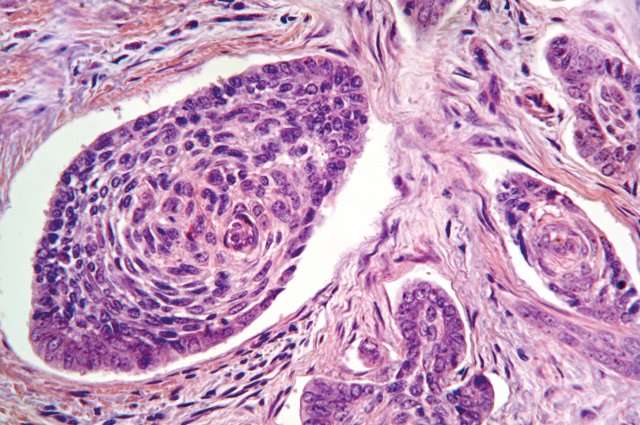Insight into a rare genetic syndrome could lead to treatments for basal cell carcinoma

When she was just 12, Julie Breneiser had her first skin cancer removed and three large tumors carved out of her jawbone. Since then she has undergone surgeries for two more jaw growths and many, many more basal cell carcinomas—"hundreds, probably close to a thousand," she estimates. "You lose count."
Such a proliferation of malignancies is typical in patients with basal cell carcinoma nevus syndrome (BCCNS), a rare genetic disease that affects between one in 18,976 to one in 55,600 people. Breneiser is board president of the BCCNS Life Support Network, which connects 850 families in the U.S., most of whom have three relatives with the syndrome. Skin and jaw tumors are hallmarks, but patients also typically suffer from several of nearly 50 other conditions, including malformation of the bones in the feet and ribs, brain tumors and glaucoma.
BCCNS is poorly understood, in part because it's so rare. Most of the research about it consists of case studies, not scientific investigations into how it develops and progresses. A team of Tufts researchers led out of the School of Dental Medicine is seeking to learn more, with an eye toward finding an effective and long-lasting treatment.
Right now, treatment options are few. The basal cell carcinomas can be cut out, but for a BCCNS patient, that means many, many surgeries over the course of a lifetime. "You start to look like a very interesting puzzle because your skin becomes a series of scar tissue," says Kristi Schmitt Burr, the BCCNS Life Support Network's executive director.
She stopped counting her own basal cell carcinomas after the 300th occurred three decades ago. One relatively new chemotherapy drug does seem able to halt the skin cancers, but it means enduring all the usual side effects of chemotherapy. Another drawback is that it can be used only for a few months at a time—and then the malignancies start coming back.
The Tufts team is marshaling the resources of cancer biology, metabolomics (the study of chemical changes that result from cellular processes), and genetics, among other fields, to identify the molecular underpinnings of BCCNS. The first target is its namesake manifestation, basal cell carcinoma. The research is funded by the Michael J. Rainen Family Foundation.
The lead scientist is Addy Alt-Holland, an assistant professor of endodontics and a cancer researcher who is an expert in engineering live tissue models of human skin to study squamous cell carcinoma, which is similar to basal cell carcinoma. The group spans Tufts institutions and includes James Baleja, an associate professor of developmental, molecular and chemical biology at the School of Medicine, and Janet Cowan, director of the Cytogenetic Laboratory at Tufts Medical Center.
Building the Right Model
It's known that BCCNS is linked to a specific mutation in the cell signaling pathway known as the sonic hedgehog, which is involved in cell growth. Undoubtedly there's more to learn, says Alt-Holland. "Cancer is a very complicated disease. More often than not, it doesn't start or end because of just one signaling pathway or one molecule going awry." One goal of the research, she says, is to figure out what else causes basal cell carcinoma, and then apply those findings to the many other tumor types associated with BCCNS.
The researchers are using human cell lines instead of mouse cells so their findings are likely to be more directly applicable to the disease. But that approach also comes with challenges. Human basal carcinoma cells are particularly uncooperative—one reason so little work has been done with them—and it took Alt-Holland and her collaborators a year to figure out how to get these cells to grow robustly.
As it turns out, unlike most cancers, these carcinomas do not rely on glucose as their main source of fuel. Instead, they prefer certain amino acids—and they seem to require the presence of certain supporting cells, like fibroblasts, for their growth.
Once they cracked that puzzle, Alt-Holland and her team began building more complicated cancer models that mimic real-life environments—3-D models of the cells' matrices built on scaffolds of collagen. The models, she says, allow the researchers to eavesdrop on the molecular conversation between the cells, and then tweak it.
The work holds hope for BCCNS patients like Breneiser and Schmitt Burr. But it may also lead to treatments for the more sporadic cases of basal cell carcinoma, the most common cancer in the world. In otherwise healthy individuals, these cancers generally can be treated with a one-off surgery, but in more complicated or advanced cases, better therapeutics are needed. And because these malignancies are a form of epithelial cancer, and epithelial cells constitute the layer of cells lining organs throughout the body, the findings may someday have wider implications.
"It's a great opportunity," says Baleja, of the medical school, whose expertise in metabolomics helped the team figure out the components needed to support the growth of human basal cell carcinomas in cultures. "What we learn from these can apply to more general diseases, because very often, the same pathways are involved," he says.
This summer, the group welcomed more collaborators, including Daniel Oreadi and Archana Viswanath from the Department of Oral and Maxillofacial Surgery at the dental school, to study BCCNS-associated jaw tumors.














